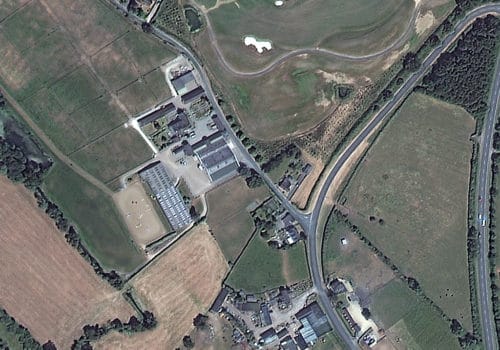
How to Buy Satellite Imagery
Satellite imagery has become one of the most powerful tools for understanding our world, capturing every detail of Earth from
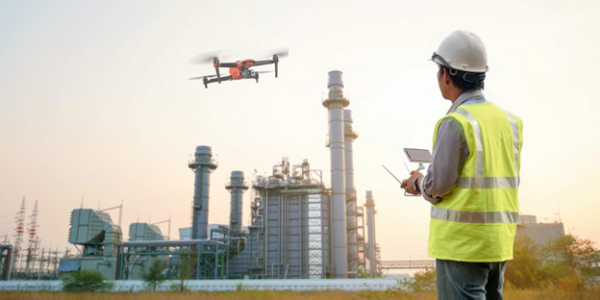
In the UAE, drone & UAV have gained significant popularity for both recreational and commercial purposes. As exciting as it is to fly a drone, there are strict rules and regulations set by authorities to ensure the safety of airspace, privacy, and security. Flying drones in restricted zones, whether accidentally or intentionally, can lead to serious consequences. Therefore, it’s crucial to understand where and how you can fly your drone in Dubai and the rest of the UAE.
This guide will take you through the General Civil Aviation Authority (GCAA) and Dubai Civil Aviation Authority (DCAA) regulations for unmanned aerial systems (UAS), the different types of fly zones based on color coding, and other essential aspects of safe drone flying in the UAE. You’ll also learn about the importance of the “My Drone Hub” app, which helps drone users navigate approved flying zones. Finally, we’ll go through all the essential steps to fly a drone legally in Dubai and the UAE.
The General Civil Aviation Authority (GCAA) and Dubai Civil Aviation Authority (DCAA) are the primary regulatory bodies responsible for airspace management and the enforcement of aviation laws in the UAE. Their role is critical in ensuring that the skies remain safe, both for traditional manned aviation and for unmanned drones.
The GCAA is the overarching body that regulates civil aviation across the UAE. It provides essential services while ensuring the safety and security of the country’s airspace. The GCAA has modernized air traffic control systems, installed radar equipment, and introduced cutting-edge facilities to accommodate the rapidly growing civil aviation sector in the UAE. Additionally, GCAA has established a regulatory framework for unmanned aerial systems (UAS), which governs the safe use of drones across the country.
The Dubai Civil Aviation Authority (DCAA) works alongside the GCAA, with a focus on regulating air traffic within Dubai. DCAA’s role is crucial, especially given Dubai’s rapid urbanization and its status as a global hub for commerce, tourism, and technology.
Both authorities emphasize the importance of flying drones within designated fly zones and ensuring compliance with privacy and safety regulations. To make this process easier for drone pilots, the My Drone Hub app provides real-time updates on approved flying zones.
Visit Our Drone Collection – Get Best Drone Camera price in Dubai, UAE
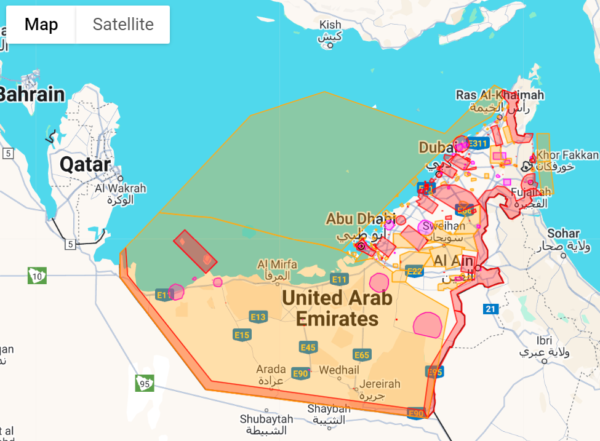
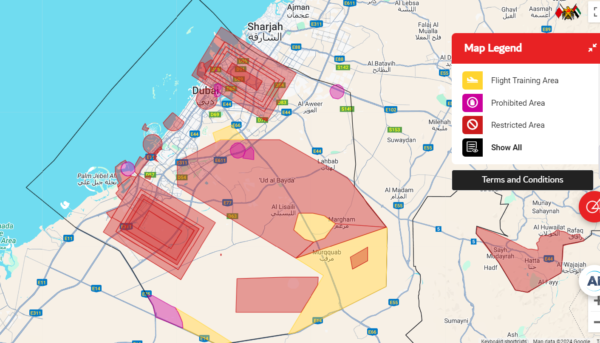
To simplify drone regulations, the UAE authorities have created a color-coded map that helps drone pilots identify where they can and cannot fly their unmanned aerial vehicles (UAVs). The color of a specific zone indicates the level of restriction and what steps a drone pilot needs to take to fly legally in that area. (check out – UAE Map & Dubai Fly Zone Map here)
Here’s a breakdown of the fly zones based on their color:
This zone is primarily designated for flight training purposes. While not restricted entirely, you need to have prior approval before flying a drone in the yellow zones. This area is ideal for beginner pilots or those looking to enhance their flying skills under controlled conditions.
In the Pink Zone, no flying is allowed under any circumstances. This is a prohibited area where drone operations, filming, and all aerial activities are strictly forbidden, with no exceptions. Areas like Marqab and Lahbab, shown on the image, fall under this category. It’s important to avoid these areas altogether to prevent any legal repercussions.
The Red Zone represents a restricted area where drone operations are not allowed without explicit permission from the GCAA. If you need to operate a drone in these zones, you must apply for approval from the GCAA. Red zones are usually located near sensitive infrastructure such as airports, military installations, and government facilities, where the risk of accidents is significantly higher.
Similar to the Red Zone, the Beige Zone is also classified as a No Fly Zone. Here, flying a drone without approval is strictly prohibited. You must obtain clearance from the GCAA before engaging in any drone-related activities. These zones often overlap with areas of high public density or critical national importance.
You can easily identify these zones by using the My Drone Hub app, available on the App Store and Google Play. The app provides up-to-date information on flying zones and helps users navigate through them. Whether you’re a recreational or commercial drone pilot, it’s essential to consult this app before each flight.
visit: How to Get Drone Permit in Dubai & UAE with complete Process and Rules
To ensure the safety of people and property, as well as the security of the airspace, the GCAA has developed a regulatory framework for the use of unmanned aerial systems (UAS). This framework covers everything from private recreational use to large-scale commercial operations. Here’s an overview of the most important drone regulations in the UAE.
If you’re flying a drone for leisure or as a hobby, you fall under the category of Individual/Private Users. The rules for recreational drone use are as follows:
Commercial drone operators in the UAE have a more stringent set of regulations to follow, including obtaining Unmanned Aircraft Operator Authorization (UOA) from the GCAA. Here’s a step-by-step guide to legally operate a drone for commercial purposes:
To get this authorization, you’ll need to:
Once you have obtained your UOA, you must apply for permission before each flight if you intend to operate in restricted zones, such as the Red Zones. If your flight involves capturing footage or using recording devices, you’ll also need to obtain Security Clearance Approval.
Commercial drone use may involve various special operations such as:
Before conducting these operations, ensure that you’ve followed all the necessary regulatory steps to avoid penalties.
In 2022, the UAE passed Federal Decree-Law No. 26 concerning the regulation of the civil use of unmanned aircraft. The main objectives of this law are:
In case of an accident or loss of control of a drone, you are required to report the incident to the GCAA immediately. You can reach them at +971506414667 or via email at aai@gcaa.gov.ae.
Flying a drone in Dubai and the UAE can be an enjoyable and rewarding experience, whether for recreation or professional purposes. However, it’s essential to adhere to all the rules and regulations set by the GCAA and DCAA to ensure the safety of the skies, as well as the privacy and security of individuals. Using the My Drone Hub app and staying informed about the various fly zones can help you avoid restricted areas and keep your drone flights compliant with the law. Always remember that the UAE takes its aviation rules seriously, and flying in restricted zones without permission can lead to legal consequences.
Now that you’re equipped with all the necessary information, you can enjoy your drone flying experience while remaining safe and legal in the UAE.
Visit – Best DJI Mini 3 Pro Alternative at Best Price
The General Civil Aviation Authority (GCAA) regulates civil aviation activities in the UAE, including drones. They ensure safety, control air navigation, and manage drone operations.
The Dubai Civil Aviation Authority (DCAA) oversees drone operations in Dubai. They regulate permissions for flying drones in both private and commercial sectors within the city.
You can fly your drone in green zones marked as permitted by the My Drone Hub app. Flying in red, beige, or pink zones requires approval from GCAA/DCAA or is strictly prohibited.
Yellow zones are designated flight training areas. Drones can fly here for training purposes, but the operator still needs authorization from GCAA/DCAA.
The pink zone is a prohibited zone where no flying or filming is allowed, including areas like Marqab and Lahbab. No exceptions apply.
To use drones for commercial purposes, you need to obtain a Unmanned Aircraft Operator Authorization (UOA) from GCAA and permission for each flight.
Yes, the minimum age for flying drones weighing more than 25 kg is 21 years. For lighter drones, recreational users of all ages can fly but should follow safety guidelines.
Recreational drones must stay within 400 feet of ground level. Flying above this height requires permission from the GCAA/DCAA.
If a drone crashes or loses control, immediately report the incident to the GCAA using the hotline or email to avoid further legal consequences.
Yes, all drones used for recreational or commercial purposes must be registered with the GCAA before flying them in any zone, including approved green zones.
Top 10 Best Drones in Construction
DJI Thermal Drone and Night Vision Drone Comparison
Autel EVO Lite Enterprise VS DJI Mavic 3 Thermal
Drone Pilot Career: Exploring Job Opportunities in the UAV Industry
Top 16 Best DJI Alternative Drones – Top DJI Drone Competitor
Detailed Guide to Photogrammetry with Drones: Best Drone with Camera
Choosing The Right Drone for LiDAR
DJI Mini 3 vs Mini 3 Pro? Which Drone Should you Buy?
DCAA and GCAA Drone and UAV Fly Zone Map in Dubai, UAE
Get UAV License and Drone Permit in UK
Best Drone in Media and Filmmaking Cinematography
Best Drone Camera for Security & Surveillance
Best Drone For Powerline Inspection
9 Best Drones for Law Enforcement: Full Guide | Benefits & Usage
Discover 23 Best Long Range Drones in 2025 (9km – 200kms)
How High Can a Drone Stay Up in the Air?
Which Was the First DJI Drone? Know Timeline, History and Future
What is the Fastest Drone in the World in 2025?
10 Best Thermal Imaging Drone and Night Vision Camera to Buy
Best Drone for Solar Panel Inspection with Thermal Imaging
The Best Budget Drone For Real Estate Photography
How to Choose the Best Drone for Roof Inspection
The Complete Guide to Autonomous Drones: Benefits, Applications & Top Models in 2025
UAE Drone Ban Lifted: Know New Drone Law in UAE
Top 10 Best Drone Filming Companies in Dubai: A Detailed Guide
Top 15 Best Drone with AI in The Market – Comprehensive Review in 2025
Can I Take a Drone to Dubai? Drone Flying Guidelines for Tourists
Bringing and Flying Drones in UAE: Laws, Customs, and Regulations
Best UAV Drone for Agriculture and Spraying
Top 10 Best Drone for Search & Rescue | Efficient & Reliable SAR Drones
Top 10 Best Drone for Construction | Efficient & Reliable Monitoring
DJI Thermal Drone and Night Vision Drone Comparison
Autel EVO Lite Enterprise VS DJI Mavic 3 Thermal Imaging Drone
Drone Pilot Career: Exploring Job Opportunities in the UAV Industry
Top 16 Best DJI Alternative Drones – Top DJI Drone Competitor

Satellite imagery has become one of the most powerful tools for understanding our world, capturing every detail of Earth from
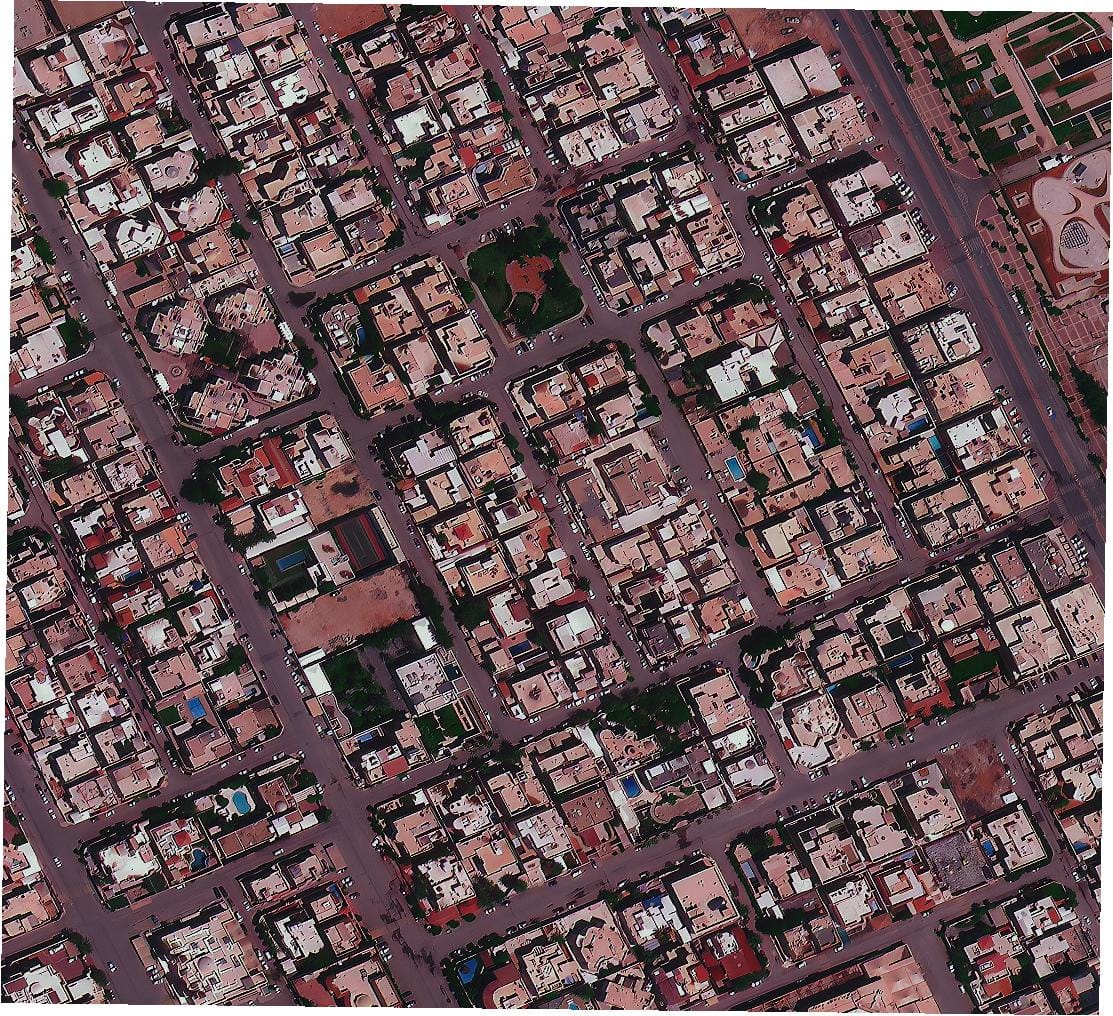
Understanding the Growing Market for Maxar Competitors Satellite imagery and geospatial intelligence have become essential for governments, industries, and research